How to Improve Reading Comprehension: Tips & Strategies
Learn how to improve reading comprehension with proven tips and strategies. Boost your understanding and become a confident reader today!
To really boost your reading comprehension, you have to switch from being a passive observer to an active participant. This means getting in there and engaging with the text—asking questions, connecting ideas to what you already know, and boiling down the main points. It’s about making a conscious shift from just seeing words to truly understanding them.
This foundational skill hinges on building up your vocabulary and background knowledge, which allows you to construct a much deeper understanding of whatever you're reading.
Start Understanding What You Read
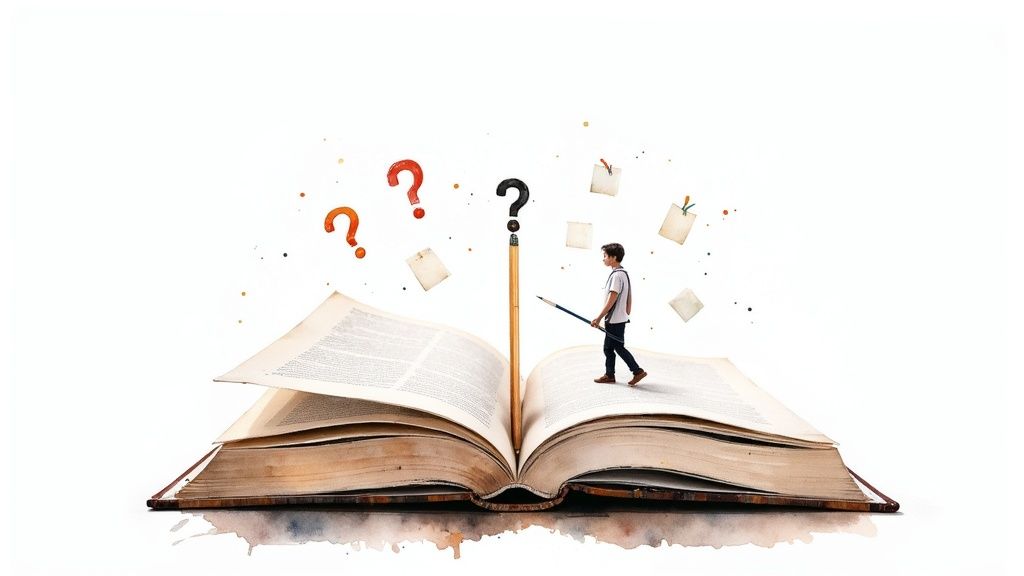
Ever read a full page, get to the bottom, and realize you have absolutely no idea what it said? We’ve all been there. Your eyes scanned the words, but your brain didn't absorb the information. Real comprehension is so much more than just recognizing letters; it's about actively building meaning and seeing the connections.
This process involves several mental gears turning at once. You’re not just decoding words—you’re weaving new information into your existing knowledge. Think of it like putting together a puzzle. Each word is a piece, but true comprehension is seeing how they all fit together to form the complete picture. This is why your purpose for reading is so important. Are you trying to learn a new skill, get lost in a story, or just hunt for a specific fact? Your goal completely changes how you approach the text.
The Pillars of Strong Comprehension
At its core, effective reading comprehension is built on two main pillars: your vocabulary and your background knowledge. It's simple, really. If you don't know what the words mean, you can’t possibly get the author’s message. Likewise, if you have zero context for the topic, the ideas will just float by without anything to latch onto.
These two pillars support each other. The more you read, the more words you learn and the more context you gain. This creates a powerful cycle that makes future reading easier and far more insightful. Starting this process early makes a huge difference. A global study of nearly 400,000 students revealed that in top-performing countries like Singapore (with reading scores of 587), about one-third of students could confidently interpret and evaluate complex texts. This just goes to show how fundamental skills set the stage for advanced understanding.
Where Do You Stand Right Now?
Before jumping into new techniques, it’s helpful to know where you're starting from. A quick self-assessment can shine a light on your current strengths and the areas that could use a little more work. This isn't about passing a test; it's just a moment for honest reflection on your reading habits.
Think back to the last complex article or chapter you tackled. Did you find yourself rereading sentences over and over? Could you explain the main argument to a friend afterward? Your gut feelings here are your first clues.
Pinpointing your specific challenges is the key to making real progress. Do you get tripped up by unfamiliar jargon? Or maybe you struggle to stay focused and link ideas from one paragraph to the next? Once you identify these hurdles, you can pick the right strategies to overcome them.
To get a clearer picture, let's do a quick self-check.
Your Reading Comprehension Starting Point
A quick self-assessment to identify your core strengths and areas for improvement in reading comprehension.
| Skill Area | Self-Assessment Question | Actionable Step on Zemith.com |
|---|---|---|
| Vocabulary | Do I often encounter words I don't know and have to skip them? | Create flashcards from the text to learn key terms using Zemith’s tools. |
| Main Idea | Can I quickly identify the central theme or argument of a text? | Use Zemith's summarizing tool to condense the text to its core points. |
| Retention | Do I forget the details of what I read shortly after finishing? | Generate a quiz from the document with Zemith to test your recall. |
| Focus | Does my mind wander when I'm reading dense or complex material? | Use Zemith to break the document into smaller chunks and create a quiz for each section. |
This little diagnostic can help you move from a general goal like "get better at reading" to a specific, actionable plan.
For a deeper dive into improving how you process information, you can find more strategies to develop your reading comprehension skills. With tools on Zemith.com, you can turn any document into a set of flashcards or a practice quiz, giving you a hands-on way to test your understanding and build a stronger foundation for everything you read.
Turn Passive Skimming Into Active Reading
We've all been there. Your eyes glide across the page, technically "reading" the words, but your mind is a million miles away. That's passive skimming—the reading equivalent of hearing noise but not actually listening. To really grasp what you're reading, you have to ditch this habit and get engaged.
Active reading isn't about moving at a snail's pace; it's about reading with intention. Think of it as a conversation with the author. You question their points, challenge their assumptions, and connect their ideas to what you already know. It’s the difference between being a passenger on a tour bus and actually driving the car.
Making this mental shift takes focus, and frankly, a bit of a game plan. Getting your attention in check is the first and most critical step. This guide on how to focus better and reclaim your attention is a great place to start, as those skills are the foundation for deeper comprehension.
Adopt a Framework for Engagement
A proven way to give your reading some structure is to use a framework. One of the best out there is the SQ3R method: Survey, Question, Read, Recite, and Review. It might sound a bit academic, but it’s a surprisingly simple and powerful way to dissect any text you encounter, from a dense technical manual to a long-form news article.
Let's say you get a 10-page report on market trends dropped on your desk. Instead of just diving in and hoping for the best, you'd use SQ3R like this:
- Survey: Before anything else, just take two minutes to look it over. Scan the headings, subheadings, any charts or graphs, and read the first and last paragraphs. This gives you a mental map of where you're going.
- Question: Now, turn those headings into questions. If a heading is "Emerging Consumer Behaviors," your question becomes, "Okay, so what are the key emerging behaviors?" This simple trick primes your brain to hunt for specific answers.
- Read: With your questions in mind, you can start reading. You’re no longer just absorbing words; you're actively searching for the information you need. It turns reading into a mission.
- Recite: After each section, hit pause. In your own words, summarize the main points. You can say it out loud, scribble a few notes, or just think it through. This is the crucial step that moves information from your short-term to your long-term memory.
- Review: When you've finished the whole report, take five minutes to glance over your notes and mentally walk through the document's main arguments. This final pass locks in your understanding.
Make Your Mark Through Smart Annotation
Covering a page in yellow highlighter might feel productive, but it's often a waste of ink. True annotation is about creating a dialogue with the text. It’s a physical record of your thought process.
The goal isn't just to remember what the author said, but to understand why they said it and what you think about it. Annotation is your tool for capturing that thought process in real-time.
This simple flow shows that active reading begins before you even read the first sentence.
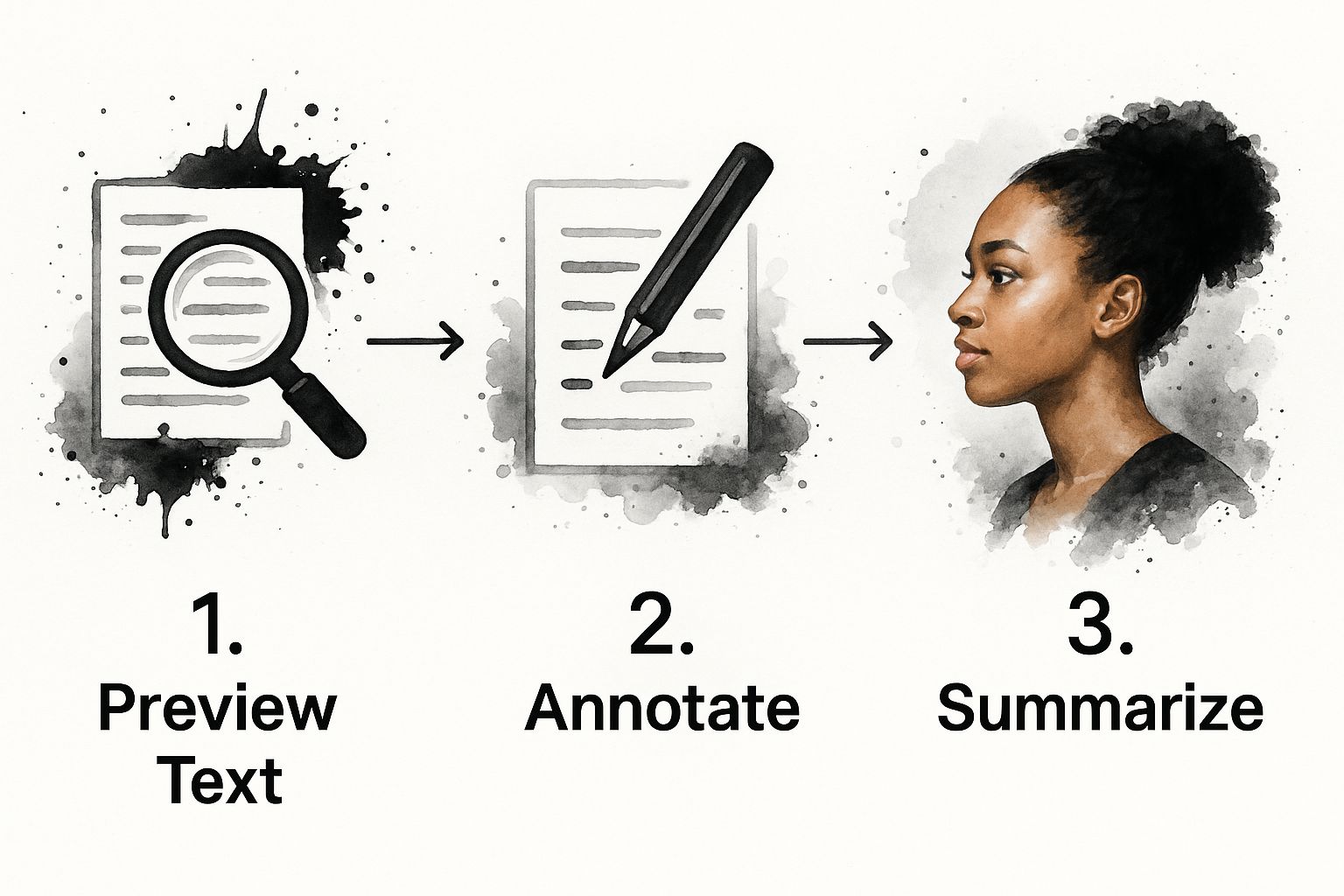
As you can see, the process starts with a preview, continues with annotation as you read, and is solidified by summarizing what you've learned.
Practical Annotation Techniques
Instead of the highlighter-happy approach, try these more surgical methods for pulling meaning from the page:
- Underline Selectively: Don't underline entire paragraphs. Force yourself to identify and underline only the single most important sentence—the main point or thesis.
- Use the Margins: This is where the real conversation happens. Scribble your questions, connections ("this is just like..."), and disagreements in the margins. Talk back to the author.
- Develop a Symbol Key: Create your own shorthand. A question mark for confusing passages, an exclamation point for surprising stats, a star for key evidence. It’s faster and more meaningful than just highlighting.
These principles work just as well for digital documents. For example, you can use a tool like Zemith to interact directly with your files. Instead of just highlighting a PDF, you could use Zemith's Document Assistant to instantly generate summaries of dense sections, identify key terms, or even create flashcards from new vocabulary. This approach transforms a static document into an interactive learning space, essentially building the principles of active reading right into your workflow. By creating a quick quiz from the document, you're automating the "Recite" and "Review" steps of the SQ3R method, which is a great way to test yourself and make sure you really absorbed the material.
Expand Your Vocabulary and World Knowledge
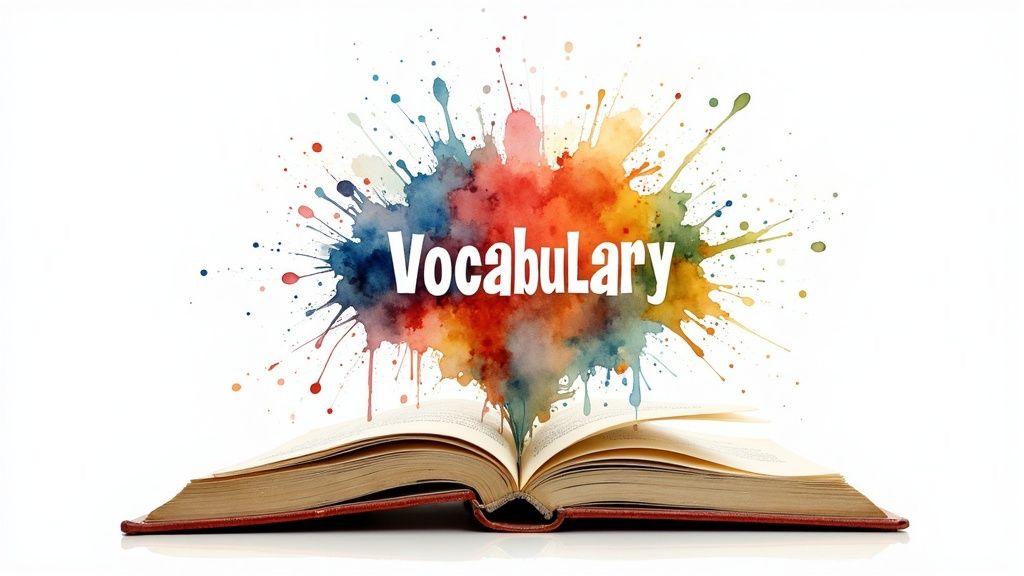
You can't really get the full picture if you don't know the words being used, and you can't grasp a new idea if you have no frame of reference for it. This is why a rich vocabulary and a solid base of general knowledge are two of the most powerful tools in your reading comprehension toolkit. The two work hand-in-hand, creating the foundation you need for any real understanding to take root.
Think about it: trying to tackle a complex article with a limited vocabulary is like trying to build a house with only a handful of brick types. You'll hit a wall pretty quickly. Likewise, reading about a topic you know nothing about is like tossing seeds on concrete—the new information has nothing to latch onto, so it just blows away.
Build Your Vocabulary Through Context
Let’s be honest, the old-school method of memorizing dictionary lists is a grind. It's not just boring; it's also not very effective. A much smarter approach is to learn new words as you actually encounter them out in the wild. When you see a word in a sentence, the context gives you clues to its meaning that a sterile definition just can't provide.
So, next time you hit an unfamiliar word, don't just skip over it. Pause for a second. Read the sentences around it and try to figure out what the author is getting at. How does this new word fit into the puzzle? Make an educated guess, then look it up to see how close you were. This active engagement forges a much stronger connection in your brain.
The real goal isn't just to memorize a word's definition. It's to get a feel for its nuance—what it implies, how it's used, and the subtle shade of meaning it carries. Learning in context is how you build that deep, intuitive understanding.
To make this a habit that sticks, you can use Zemith to instantly generate flashcards from any document. The simple act of creating a flashcard deck for new terms helps lock them into your memory. For some great tips on this, check out our guide on how to create flashcards that you'll actually use.
Decode Words by Breaking Them Down
Here's another trick that works wonders: start looking for word parts. A huge chunk of the English language is built from Greek and Latin roots, prefixes, and suffixes. If you learn to spot these common building blocks, you can decipher thousands of words you've never even seen before.
- Prefixes: These are tacked onto the beginning of a word to change its meaning (e.g., un- means "not," re- means "again").
- Roots: This is the core of the word, holding its essential meaning (e.g., port means "to carry," scrib means "to write").
- Suffixes: Added to the end, these often tweak a word's function (e.g., -able means "capable of," -ology means "the study of").
For instance, if you know that bene- means "good," fac means "to make," and -or means "a person who does," you can instantly work out that a benefactor is someone who does good things. It’s a much more scalable way to grow your vocabulary than just brute-force memorization.
Cultivate Your Background Knowledge
All the information you've gathered over your life—often called your schema—acts like a mental filing system. When you read something new, your brain immediately tries to find the right folder to put it in. If a relevant folder doesn't exist, that new piece of info is left floating around with nowhere to go, and it's usually forgotten pretty quickly.
This is exactly why building a broad base of knowledge is so crucial for comprehension. The more you know about different subjects—history, science, art, current events—the more "hooks" you have to hang new information on. It creates a powerful cycle: the more you know, the easier it becomes to learn even more.
This also shows how fragile reading skills can be. Take the COVID-19 pandemic, for example, which caused very real setbacks in reading proficiency around the world. Data from 31 countries showed that 71% of them saw an increase in students falling behind, as disruptions to education weakened their foundational knowledge. This is where tools like Zemith can be incredibly helpful; they allow you to quickly summarize articles and pull out key ideas, making it easier than ever to build your knowledge base on any topic that catches your eye.
Learn to Read Between the Lines
Great reading isn't just about understanding the words on the page. It's about developing an instinct for what's not being said. This is where you learn to read between the lines—to question an author's motives, spot their biases, and really dig into how strong their arguments are.
When you master this, you stop being a passive reader and become an active, critical thinker. You start approaching texts like a detective, hunting for clues in the tone, the specific words chosen, and the evidence (or lack thereof) that's presented. The question shifts from "What are they saying?" to "Why are they saying it this way?"
Distinguishing Fact from Opinion
One of the first habits to build is separating solid, verifiable facts from an author's personal take. It sounds easy, but opinions are often cleverly dressed up to look like facts, and it takes a sharp eye to tell them apart.
A fact is something you can prove. "The Earth revolves around the Sun" is a fact. An opinion, on the other hand, is a judgment or belief, like "Science fiction is the most interesting genre." There's no objective way to prove that.
To get better at this, start questioning what you read. Ask yourself, "How could I check this?" If an author drops a statistic, look for the source. If they make a bold claim, see if it's backed by credible proof or if it’s just their perspective. It’s all about developing an analytical mindset.
The point isn't to become a cynic who distrusts everything. It's about cultivating a healthy skepticism that allows you to confidently sort a well-supported case from a strong personal viewpoint.
Uncovering the Author's Purpose and Bias
Every piece of writing has a purpose. The author might want to inform you, persuade you, or simply entertain you. Figuring out that purpose is huge because it gives you the context for everything else. An article written to sell a product will use language and present information very differently from a neutral academic study.
Hand-in-hand with purpose comes bias—the author's natural lean in a particular direction. Bias isn't inherently bad, but if you don't see it, it can easily color your own understanding.
Keep an eye out for these clues to an author's purpose and bias:
- Word Choice: Is the language emotionally charged ("catastrophic," "breakthrough") or is it more neutral and objective?
- What's Missing?: Are they only showing one side of the story? A one-sided argument is often a dead giveaway that you're not getting the full picture.
- The Source: Where is this published? A personal blog, a major news outlet, or a company's marketing site? The source itself tells you a lot about the likely intent.
Evaluating Arguments and Synthesizing Information
A strong argument is built on a solid foundation of logic and good evidence. A weak one? It often relies on emotional pleas, faulty logic, or just not enough proof. As you read, get into the habit of taking arguments apart. Do the conclusions actually follow from the evidence provided?
The final piece of the puzzle is synthesis. This is where you bring it all together. Instead of just taking one author's word for it, you compare their take with other sources. You look for where different accounts agree and disagree, and from there, you build your own, more complete understanding.
This kind of critical evaluation is more important than ever. While OECD data shows that 74% of 15-year-olds in member countries have basic reading skills, the real challenge is developing these higher-level analytical abilities. You can read more about these findings from the OECD to see the full scope.
This entire skillset is directly tied to your ability to think critically. For a deeper dive into strengthening that core competency, check out our guide on how to improve critical thinking skills. With consistent practice, you can sharpen this ability and become a truly powerful reader and thinker.
Create Your Daily Comprehension Habit

Real, lasting improvement in reading comprehension isn’t something you can cram for overnight. It’s a skill, and like any other skill, it gets stronger with consistent practice. The secret is to weave powerful reading strategies into your everyday life until they become second nature.
Forget trying to find hours in your already packed schedule. The most effective way I’ve seen people succeed is by starting small. Just 15 minutes of focused practice a day is far more powerful than a three-hour binge once a month. This kind of consistency is what really trains your brain to engage with texts actively and critically.
The whole point is to build a routine that feels doable, not daunting. When you commit to a brief daily session, you start building momentum and proving to yourself that you can make steady, meaningful progress.
Design Your 15-Minute Daily Workout
To keep this daily practice from getting stale, you need to mix things up. I always recommend focusing on a different micro-skill each day. This targets all the different facets of comprehension without causing burnout, keeping you engaged while you build a well-rounded skillset.
So, what does that look like in practice? Monday, you might spend your 15 minutes summarizing a short news article in just three sentences. On Tuesday, you could take a single dense paragraph from a textbook and scribble questions in the margins. This variety prevents boredom and strengthens different mental muscles.
This approach is all about working smarter, not harder—a principle that's key to sustainable learning. If you're looking for more ways to get the most out of your study time, our guide on how to study smarter, not harder has some great strategies that pair perfectly with this daily reading habit.
A great habit is built on a clear plan. Instead of a vague goal like "I'll read more," a specific schedule gives you a concrete, achievable target for each day. It removes the guesswork and makes it so much easier to stay on track.
Here’s a sample schedule to get you started. It mixes different strategies throughout the week, ensuring you cover all your bases in just a few minutes a day.
Your Weekly Reading Comprehension Workout Plan
This is a sample schedule you can adapt to integrate different comprehension strategies into your week. The goal is consistent, varied practice for steady improvement.
| Day | Focus Activity (15-20 mins) | Goal |
|---|---|---|
| Monday | Summarize: Read a short article and use Zemith to generate a one-paragraph summary. Compare it to your own. | Practice identifying and articulating the core message. |
| Tuesday | Question: Read a chapter from a book and jot down at least three questions about the text in Zemith's notepad. | Engage actively with the material and look for deeper meaning. |
| Wednesday | Vocabulary: Identify five unfamiliar words from your reading and use Zemith to create a flashcard deck. | Systematically expand your vocabulary in context. |
| Thursday | Predict: Read the first half of an essay and write down what you think will happen next. | Improve your ability to follow an argument's logical flow. |
| Friday | Connect: Relate one key idea from your reading to a personal experience or another text. | Strengthen retention by creating meaningful personal connections. |
This plan is just a template, of course. Feel free to swap out activities based on what you need to work on most. The key is simply to have a plan and stick with it.
Choose Materials That Challenge You
The final piece of the puzzle is selecting the right things to read. You want to find your "sweet spot" of difficulty—something that stretches your skills but doesn't leave you feeling completely lost. If the text is too easy, you won’t grow. If it's impossibly difficult, you'll just get frustrated and give up.
Look for articles, essays, or book chapters that are just a little bit above your current comfort level. Maybe it’s an article on a topic you’re less familiar with or an author with a more complex writing style. This ensures you're constantly, but gently, pushing your boundaries.
The Document Assistant on Zemith.com can be a huge help here. If you find a challenging article, you can use it to instantly generate a summary to check if you grasped the main points. You can even create a quick quiz to test your recall. This gives you immediate feedback, helping you see the tangible results of your daily habit and stay motivated.
Your Reading Comprehension Questions, Answered
As you start using these new reading strategies, you're bound to run into a few questions. I've been there. Think of this as a quick FAQ to help you navigate some of the most common bumps in the road. Getting past these sticking points is key to building real momentum.
It’s one thing to read about a technique in an article, but it's a completely different ballgame when you're trying to apply it and hit a wall. Let's tackle some of those common frustrations head-on.
How Long Until I Actually See a Difference?
This is the big one, isn't it? Everyone wants to know when the hard work pays off. While it's different for everyone, here’s a realistic benchmark: with about 20-30 minutes of focused, consistent practice each day, most people start to notice a real shift in their understanding within 4 to 6 weeks.
Progress here isn't like flipping a switch; it's more like strengthening a muscle. It happens gradually. The secret is consistency, not cramming. Just pick one strategy to start—maybe summarizing what you read after each page. Once that becomes second nature, layer in another. The small daily efforts compound in ways that a single, long study session never could.
Don't get caught up in trying to be perfect from day one. Focus on being persistent. A little bit of deliberate effort every single day is far more powerful than trying to do it all at once. You're building a sustainable habit, not running a sprint.
It can also help to see your progress. This is where a tool like Zemith can be a real game-changer. After reading an article, you can use it to generate a quick quiz. Watching your scores tick upward week after week is incredibly motivating and proves that your daily practice is working.
What’s the Best Way to Stay Focused While I’m Reading?
Let's be honest: distraction is the number one enemy of comprehension. To really absorb what you're reading, you have to create a space that tells your brain it's time to lock in. The most impactful first step? Deal with your phone. Put it on silent and, even better, put it in another room.
A fantastic technique for training your focus is the Pomodoro Method. It's incredibly simple but effective. You read with 100% focus for 25 minutes, then take a mandatory 5-minute break. Get up, stretch, walk around—anything but look at another screen. This cycle prevents your brain from getting fried and keeps you sharp.
To stop your mind from wandering during those focused 25-minute blocks, try making your reading more physical.
- Use your finger or a pen to guide your eyes along the text. This simple physical action keeps your eyes anchored and prevents them from skipping around the page.
- Get your pen moving. Actively underline key ideas or scribble questions in the margins. You can use Zemith's Smart Notepad to do this digitally, keeping all your thoughts organized and searchable.
These small physical acts turn reading from a passive activity into an active one, making it much harder for your mind to drift off.
Is Reading on a Screen Really Worse for My Comprehension?
It certainly can be, but it doesn't have to be. The real problem is that we’ve trained ourselves to skim and scroll on screens, which naturally leads to a more shallow reading experience. The trick is to consciously fight that habit and apply the same active reading strategies you would with a book.
When you're reading on a screen, make a deliberate choice to slow down. Use your browser's "reader mode" to strip away all the distracting ads and pop-ups. I also find that bumping up the font size a little bit can make a huge difference in reducing eye strain.
You can also turn digital tools into an advantage. Zemith's Document Assistant is invaluable for dense or technical material. You can upload a document and ask it to summarize a confusing paragraph or define a key term, essentially building a comprehension sidekick into your workflow. At the end of the day, the strategies you use matter far more than whether you're reading on a screen or on paper.
Ready to see how smart AI tools can help put these strategies into practice? Zemith brings everything together in one place—from a Document Assistant that creates summaries and quizzes to a Smart Notepad that organizes your thoughts. Stop juggling different apps and start building a more effective reading habit today. You can explore all the features at https://www.zemith.com.
Explore Zemith Features
Introducing Zemith
The best tools in one place, so you can quickly leverage the best tools for your needs.
All in One AI Platform
Go beyond AI Chat, with Search, Notes, Image Generation, and more.
Cost Savings
Access latest AI models and tools at a fraction of the cost.
Get Sh*t Done
Speed up your work with productivity, work and creative assistants.
Constant Updates
Receive constant updates with new features and improvements to enhance your experience.
Features
Selection of Leading AI Models
Access multiple advanced AI models in one place - featuring Gemini-2.5 Pro, Claude 4.5 Sonnet, GPT 5, and more to tackle any tasks
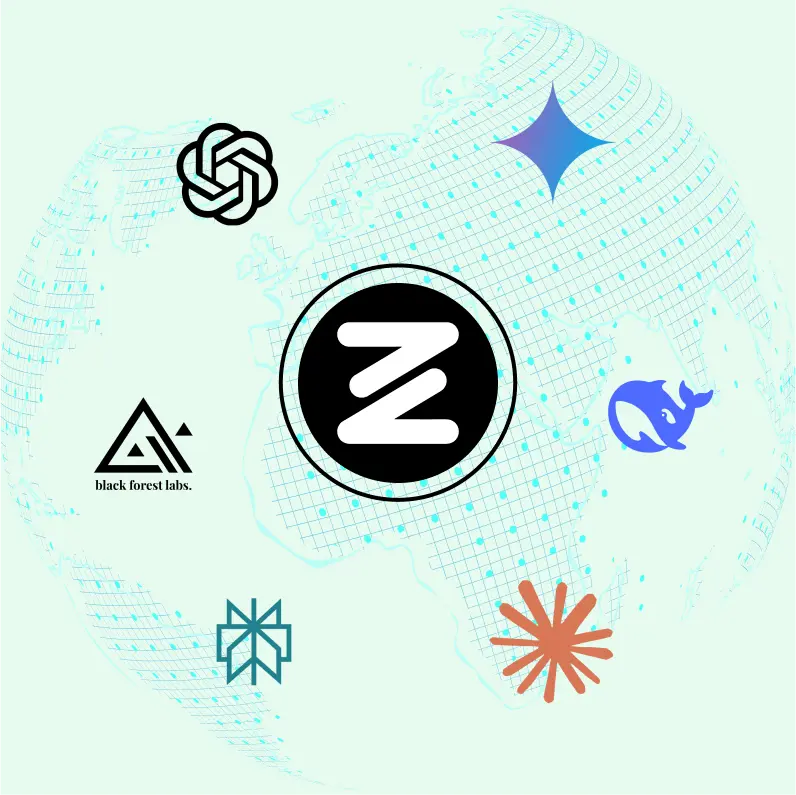
Speed run your documents
Upload documents to your Zemith library and transform them with AI-powered chat, podcast generation, summaries, and more
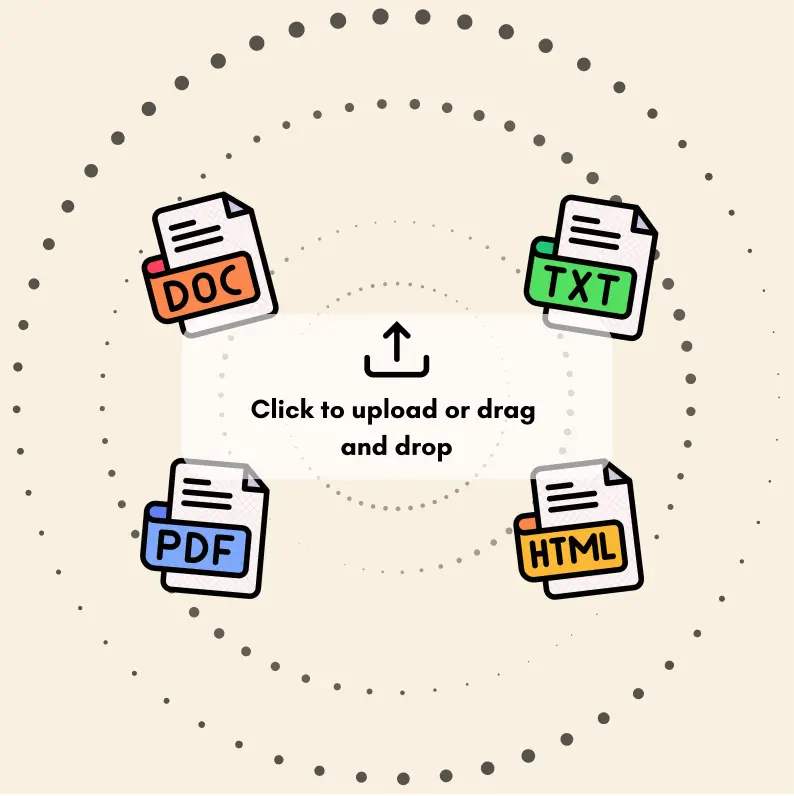
Transform Your Writing Process
Elevate your notes and documents with AI-powered assistance that helps you write faster, better, and with less effort
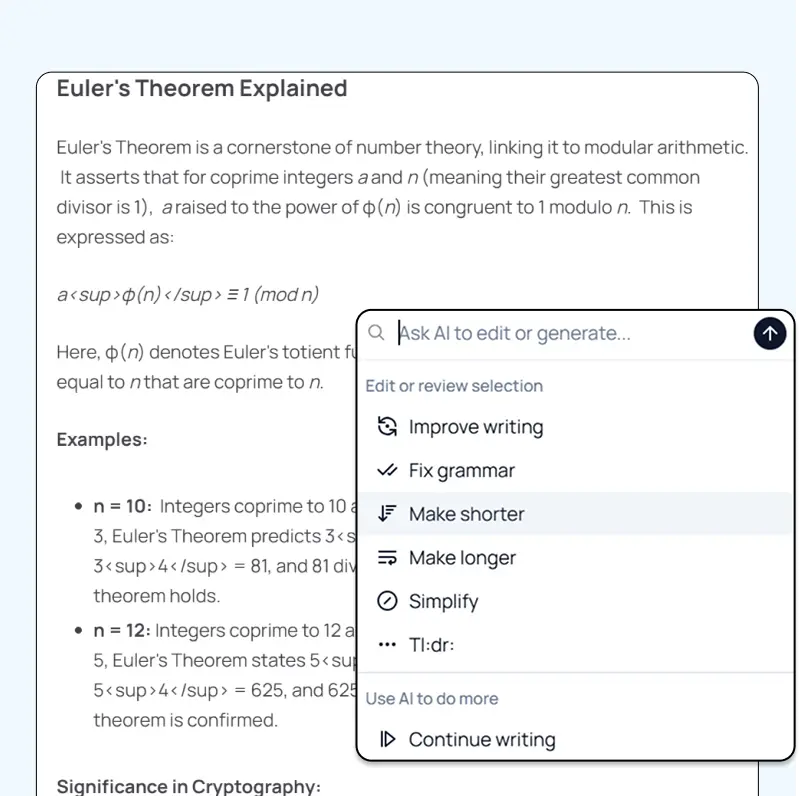
Unleash Your Visual Creativity
Transform ideas into stunning visuals with powerful AI image generation and editing tools that bring your creative vision to life
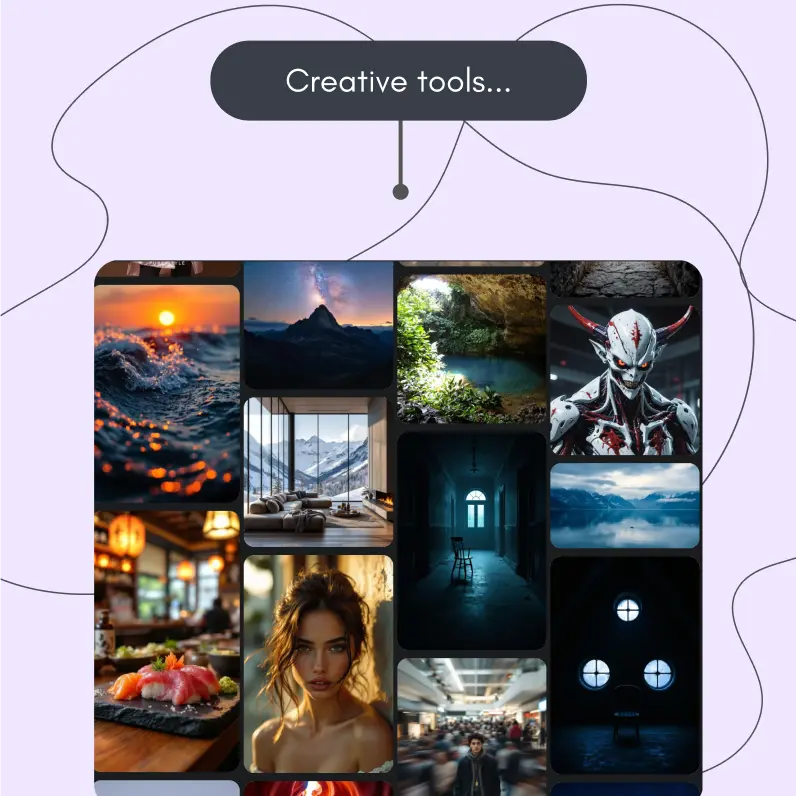
Accelerate Your Development Workflow
Boost productivity with an AI coding companion that helps you write, debug, and optimize code across multiple programming languages
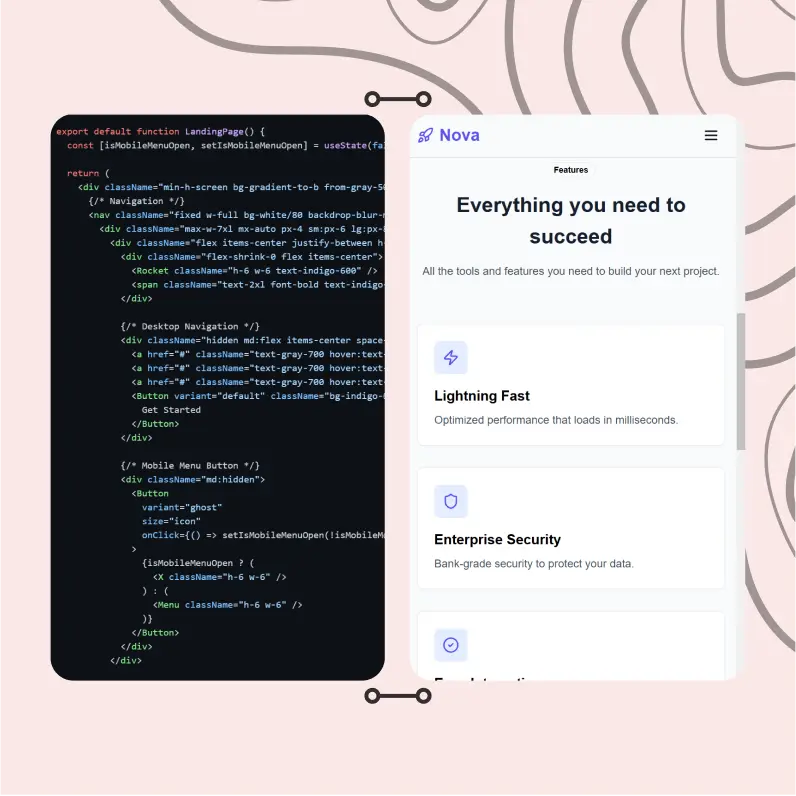
Powerful Tools for Everyday Excellence
Streamline your workflow with our collection of specialized AI tools designed to solve common challenges and boost your productivity
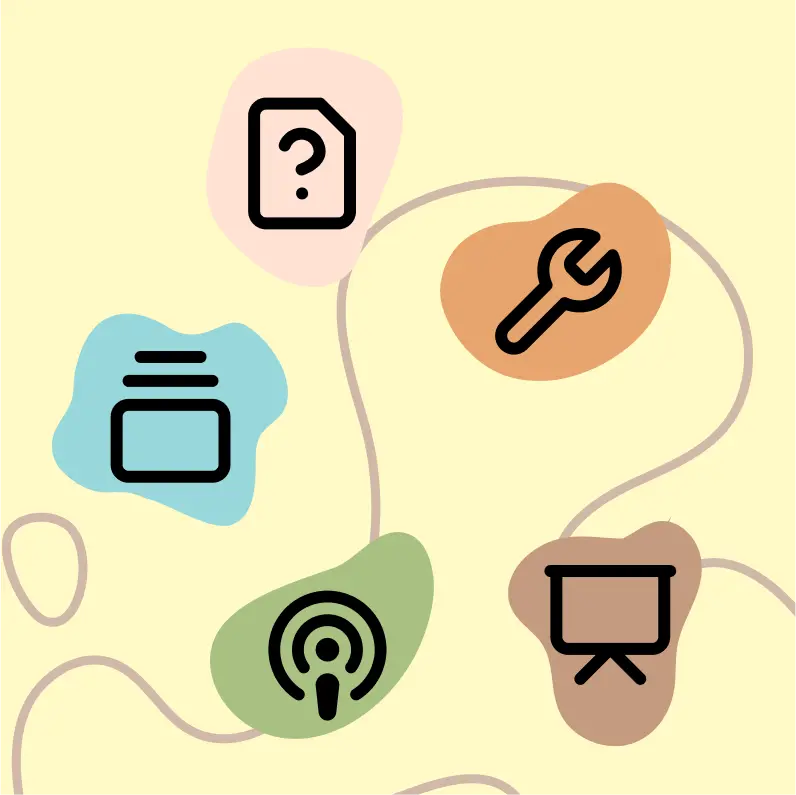
Live Mode for Real Time Conversations
Speak naturally, share your screen and chat in realtime with AI

AI in your pocket
Experience the full power of Zemith AI platform wherever you go. Chat with AI, generate content, and boost your productivity from your mobile device.

Deeply Integrated with Top AI Models
Beyond basic AI chat - deeply integrated tools and productivity-focused OS for maximum efficiency
Straightforward, affordable pricing
Save hours of work and research
Affordable plan for power users
Plus
- 10000 Credits Monthly
- Access to plus features
- Access to Plus Models
- Access to tools such as web search, canvas usage, deep research tool
- Access to Creative Features
- Access to Documents Library Features
- Upload up to 50 sources per library folder
- Access to Custom System Prompt
- Access to FocusOS up to 15 tabs
- Unlimited model usage for Gemini 2.5 Flash Lite
- Set Default Model
- Access to Max Mode
- Access to Document to Podcast
- Access to Document to Quiz Generator
- Access to on demand credits
- Access to latest features
Professional
- Everything in Plus, and:
- 21000 Credits Monthly
- Access to Pro Models
- Access to Pro Features
- Access to Video Generation
- Unlimited model usage for GPT 5 Mini
- Access to code interpreter agent
- Access to auto tools
- 10000 Credits Monthly
- Access to plus features
- Access to Plus Models
- Access to tools such as web search, canvas usage, deep research tool
- Access to Creative Features
- Access to Documents Library Features
- Upload up to 50 sources per library folder
- Access to Custom System Prompt
- Access to FocusOS up to 15 tabs
- Unlimited model usage for Gemini 2.5 Flash Lite
- Set Default Model
- Access to Max Mode
- Access to Document to Podcast
- Access to Document to Quiz Generator
- Access to on demand credits
- Access to latest features
- Everything in Plus, and:
- 21000 Credits Monthly
- Access to Pro Models
- Access to Pro Features
- Access to Video Generation
- Unlimited model usage for GPT 5 Mini
- Access to code interpreter agent
- Access to auto tools
What Our Users Say
Great Tool after 2 months usage
simplyzubair
I love the way multiple tools they integrated in one platform. So far it is going in right dorection adding more tools.
Best in Kind!
barefootmedicine
This is another game-change. have used software that kind of offers similar features, but the quality of the data I'm getting back and the sheer speed of the responses is outstanding. I use this app ...
simply awesome
MarianZ
I just tried it - didnt wanna stay with it, because there is so much like that out there. But it convinced me, because: - the discord-channel is very response and fast - the number of models are quite...
A Surprisingly Comprehensive and Engaging Experience
bruno.battocletti
Zemith is not just another app; it's a surprisingly comprehensive platform that feels like a toolbox filled with unexpected delights. From the moment you launch it, you're greeted with a clean and int...
Great for Document Analysis
yerch82
Just works. Simple to use and great for working with documents and make summaries. Money well spend in my opinion.
Great AI site with lots of features and accessible llm's
sumore
what I find most useful in this site is the organization of the features. it's better that all the other site I have so far and even better than chatgpt themselves.
Excellent Tool
AlphaLeaf
Zemith claims to be an all-in-one platform, and after using it, I can confirm that it lives up to that claim. It not only has all the necessary functions, but the UI is also well-designed and very eas...
A well-rounded platform with solid LLMs, extra functionality
SlothMachine
Hey team Zemith! First off: I don't often write these reviews. I should do better, especially with tools that really put their heart and soul into their platform.
This is the best tool I've ever used. Updates are made almost daily, and the feedback process is very fast.
reu0691
This is the best AI tool I've used so far. Updates are made almost daily, and the feedback process is incredibly fast. Just looking at the changelogs, you can see how consistently the developers have ...
